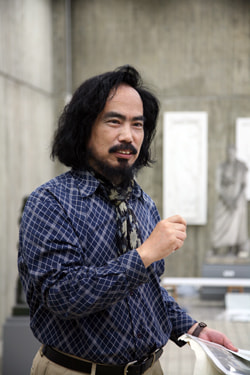
Professor Tetsuya Sakata, Department of Painting (Oil Painting)
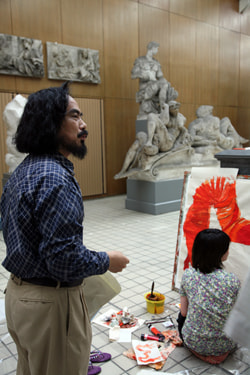
In the quiet plaster figure room, only the faint sound of applying brush strokes to canvases could be heard.
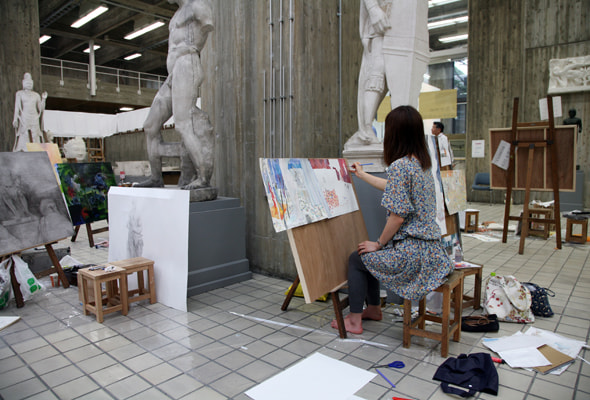
In the plaster figure room that is emblematic of the Faculty of Fine Arts, an oil painting class titled "Reentrance Examination" was held. Students spent 5 weeks to express the space where plaster figures are placed and the movements of human bodies, for an assignment to depict a scene in which women wearing red, blue, yellow and green costumes stand close or still, do something repeatedly, move and gather in a forest of plaster figures. Since students in this class also depicted spaces where models existed in their entrance exams, it seems that "Reentrance Examination" reminds students of a feeling of tension and memory during the entrance exams. Professor Sakata said that, since many students have depicted static objects before, it is an attempt to have students pay attention to postures of models moving independently in the space of the plaster figure room and colors that are the basis for pictorial expressions and depict the space and human bodies, using the primary colors of light and colors.(continued in the lower column)
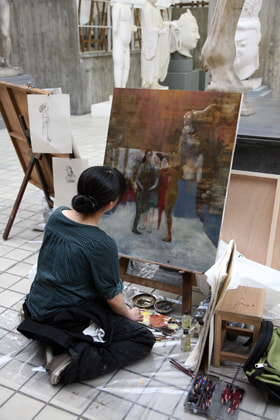
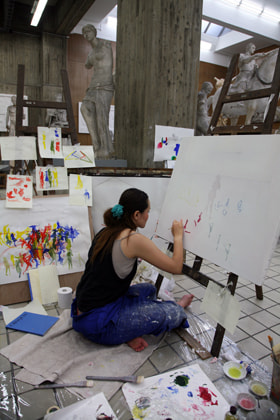
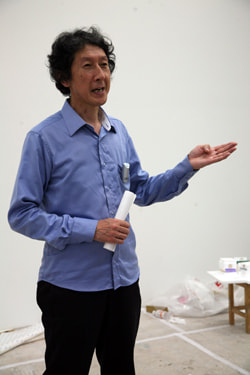
Professor Hirotoshi Sakaguchi, Department of Painting (Oil Painting)
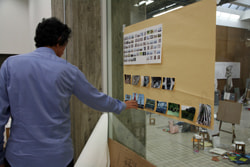
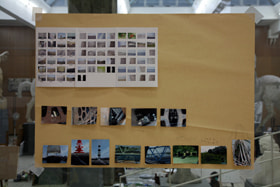
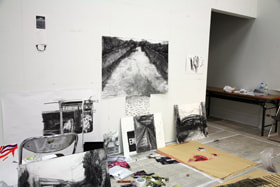
In the art space of the Painting Hall, practical training that combines lectures and exhibition was held.
Professor Sakaguchi said that students tackle a task called "Artistic Expressions related to Ordinary-Extraordinary and Continuity-Discontinuity," in which they deduce themes from familiar, everyday events and personal experiences while recognizing new trends in the world. Students took a field trip to Tokyo Sky Tree, located east of Tokyo University of the Arts, using Taito City's community bus "Megurin," and purchased intriguing objects at Kappabashi Dougu Street. Then, they visited Sumidagawa Park, placed those objects in the park and took pictures of the objects against Tokyo Sky Tree under construction, and also gathered information about the surrounding area. The following week, they went to Koishikawa Botanical Garden, located west of the university, and received explanations about how the garden staff have grown and studied trees in the world, including a tree that was grafted from the apple tree under which Isaac Newton made his discovery of the principle of gravity. In this way, after gathering information about what have been happening in the eastern and western sides of Tokyo University of the Arts, students think about how to figure out ordinary and extraordinary, and express those in their own ways. For example, one of animation works is made frame by frame, and scenes in a train, which are depicted by two students, are added to it. A variety of expressions, including videos, three-dimensional works and paintings, are created, and critiques are conducted while displaying their works. The point is that how students view extraordinary. Although modernization has been advanced by putting together extraordinary and separating it from ordinary since the Meiji Period, it is necessary for each student to reconfirm that extraordinary is situated nearby if regarding people's dreams and past customs as extraordinary.(continued in the lower column)
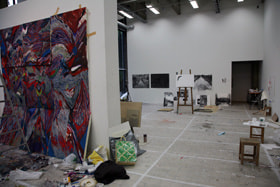
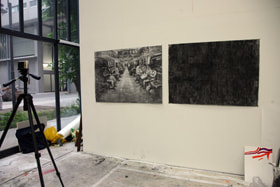
Kappabashi Dougu Street is more enjoyable than ordinary shopping streets, and it is good to take foreigners to the street. Students become conscious of things that they have got attached to, been interested in or expressed nonchalantly by placing objects that they find intriguing in urban scenes. Although students in the Department of Painting are tested whether they have basic skills of expression in entrance exams, it is very difficult to get students who also have originality of expression. They follow a fixed pattern if they pursue recognition too much after entering the university. Professor Sakaguchi said that the sophomore year is the time to raise issues for redeveloping their own creative styles. Although drawing is the basics, students often take pictures of materials by digital cameras because digital information is easy to use. Students seem not to have a sense of discomfort when they draw from photographs. Students should know the difference between two naked eyes and a single eye of a camera. They can use any materials and tools. Representations themselves are important, so there is no restriction on materials from which they create art works. In the Department of Painting (Oil Painting), creation of oil paintings is regarded as a step to advance pictorial expressions, so students do not stick to oil paintings. Although it may be surprising, animations are animated only after images of paintings are used as frames. Professor Sakaguchi said that there are discontinuous gaps between frames, and that he teaches students that objects are perceived as moving because eyes fill in the gaps. Students fully express their imaginations by using a variety of methods and tools, including drawing, installation, photograph and video.(continued in the lower column)
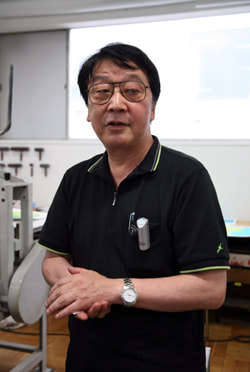
Professor Takemi Azumaya
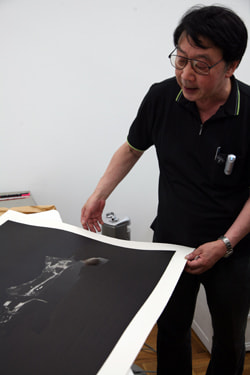
Professor Takemi Azumaya, Department of Painting (Printmaking)
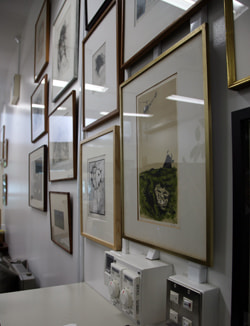
Besides Professor Azumaya's prints, works by artists who are closely associated with the print course, including Ryohei Koiso, Gyoji Nomiyama, Tadashige Ono, Matazo Kayama, Tadashi Sugimata, Kunio Komatsuzaki, Kazu Wakita, Tokuzo Okabe, Masuo Ikeda and Odilon Redon, are exhibited in the print course room.
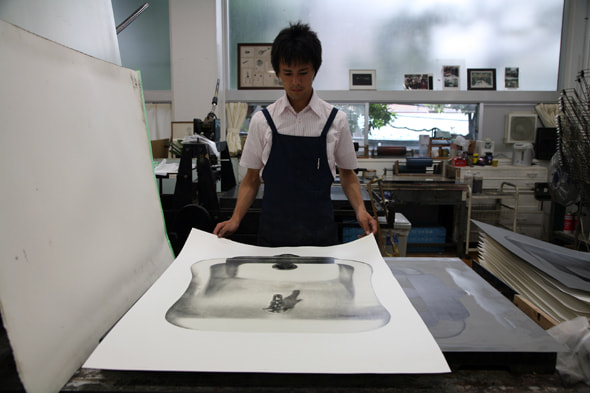
According to Professor Azumaya, undergraduate and graduate students create their works in the same room. He said that there are Lithograph, Copperplate Print, Woodblock Print and Silk Screen courses, and that Tokyo University of the Arts is the only university that has the 4 printmaking courses in Japan. Although limestone called Lithographic Limestone is basically used to print lithographs, students frequently use aluminum plates because large prints can be printed by using them. Professor Azumaya also said that very large prints have recently increased.
There are many foreign students, including students from Asia, Europe and the United States. Lithographic Limestone is mined only from strata in Germany and Italy and one piece of it is very heavy at approximately 40 kg. It is impossible for one person to handle it, so aluminum plates are mainly used nowadays. Lithographic Limestone is polished by sand and used again. According to Professor Azumaya, there are some students who stick to Japanese paper, but as far as lithograph is concerned, machine-made paper is easy to use for printmaking. In the Woodblock Print course, water-based woodblock prints are mainly created. Students study multicolored printing methods that use "Kento," or a mark made on printing blocks of Ukiyo-e, and create modern woodblock prints. The size of Ukiyo-e is predetermined, and it is slightly larger than a "shiroku" size, 127-188 mm. Sizes of current woodblock prints are generally large, which are submitted to competitions or are displayed in exhibitions. Also, there is a foreign student from Bangladesh, who has studied Japanese water-based woodblock prints.
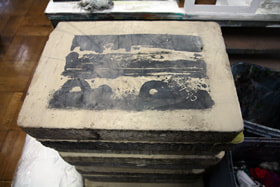
Lithographic Limestone
Plates of large and heavy Lithographic Limestone used for lithograph are piled up in the studio.
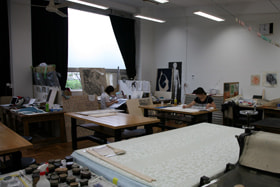
Print Course Room
Students eagerly create woodblock prints and lithograph in the quiet and calm studio.
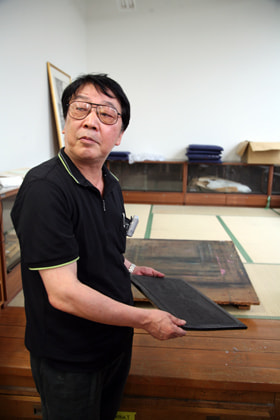
Professor Azumaya also stores old printing blocks, and studies their printing techniques and restores the blocks.
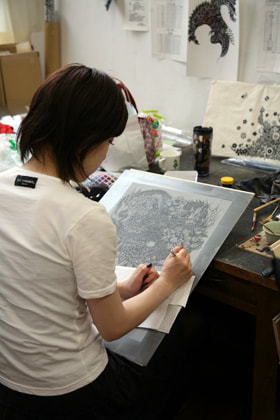
Women have increasingly entered every course, and delicate designs and detailed expressions only women would be capable of are found.

Professor Tetsuya Sakata, Department of Painting (Oil Painting)

In the quiet plaster figure room, only the faint sound of applying brush strokes to canvases could be heard.

Professor Hirotoshi Sakaguchi, Department of Painting (Oil Painting)


Professor Takemi Azumaya

Professor Takemi Azumaya, Department of Painting (Printmaking)

Besides Professor Azumaya's prints, works by artists who are closely associated with the print course, including Ryohei Koiso, Gyoji Nomiyama, Tadashige Ono, Matazo Kayama, Tadashi Sugimata, Kunio Komatsuzaki, Kazu Wakita, Tokuzo Okabe, Masuo Ikeda and Odilon Redon, are exhibited in the print course room.



















